Speaking for Statistics: In-Reach and Outreach Communication
December brings us to the close of a successful year for the ASA and to the threshold of 2013, the International Year of Statistics. During the past year—in conversations with ASA members throughout the United States and several other countries—the question I have heard most often is, “How can we build greater awareness of our profession?” The New Year offers many opportunities to tell colleagues, students, and the public about the accomplishments of our association and the contributions of our field.
In-Reach: Members Communicating with Members
The first audience we must reach is ourselves! As ASA members, we should know how our association is promoting the practice and profession of statistics. In-Reach Communication, an initiative I announced in my January column, equips you to present the most important activities of our association within your local statistical community.
The in-reach communication workgroup, led by Jeri Mulrow, has developed short, informative, out-of-the-box presentations that you can give to audiences of colleagues and students. Slide sets are available for the following topics:
Conference on Statistical Practice
Ethical guidelines for statistical practice
Significance magazine and website
STATtr@k website for new statistics professionals
Volunteering in the ASA
You can download these slides from the Members Only section of the ASA website. Click on “My Volunteer Activities” and then on “Informational Slides About the ASA.” Each set is a stand-alone presentation and comes with a script.
At JSM, the workgroup introduced the presentations during the Council of Chapters workshop. Mulrow reports that “surprisingly, not everyone was aware of the different activities of ASA—and even if they were aware, they did not necessarily know the information in the presentations.”
She adds that the presentation on accreditation garnered the most questions. “There was awareness of this activity, but not a clear understanding. The presentation was a good way to get a conversation going on the topic.”
According to Mulrow, “There is nothing like the personal touch of member-to-member communication, because it generates conversations and stimulates curiosity. The ASA has many great things going on, and it is hard to keep up with them. So the more ways we can convey what our association is doing, the more people we can reach.”
This fall, Dan Jeske gave several of the presentations to the Portland and Montana chapters. He recommends that chapter officers give in-reach talks at their meetings and says, “This will help members become more engaged with our association.”
Mulrow and Jeske emphasize that an in-reach talk requires as little as 15 minutes of preparation. As Jeri explains, “Talking points are provided for each slide and cover commonly asked questions. An ASA staff contact is provided for follow-up questions. You could present one, some, or all of the topics at a meeting. You can pick a topic, drop those slides into your own presentation, and go!”
I am grateful to the workgroup members—Brenda Gaydos, Sue Hilsenbeck, Jeske, Eileen King, David Morganstein, Kathleen Morrissey, Mulrow, Jennifer Schumi, and Ron Wasserstein—for creating these presentations. Try them out at your next meeting!
StatFest: Members Communicating with Students
The second audience we must reach is students. To expand the pipeline for our undergraduate and graduate programs, we must seize every opportunity to explain to young people that statistics is a rewarding field with an amazing range of career options.
A wonderful model for this type of outreach is StatFest, an annual conference for students that is organized by the ASA Committee on Minorities in Statistics to increase diversity in the statistical sciences.
StatFest 2012 took place at San Francisco State University (SFSU) on October 6. The program featured informative and inspirational presentations by ASA members, including graduate students who shared advice about succeeding in graduate school.
Juanita Tamayo Lott, who helped host StatFest 2012, reports that it drew 82 attendees. Students came from schools throughout the Bay Area and as far away as San Diego and Davis. Demographically, the participants were highly representative of California’s population.
Brian Millen, chair of the Committee on Minorities, said, “What distinguishes StatFest is the accessibility of the speakers. Students directly interact with role models in the field who are generous with their time and are committed to helping students make career choices.”
Students at StatFest benefited greatly from this interaction. Amy Gu, a senior statistics major at the University of California, Berkeley, told me, “StatFest confirmed my plans to pursue a graduate degree in statistics. I gained insight into possible career paths by speaking to statisticians in academia who create new methodologies, as well as statisticians in applied fields including pharmaceuticals, public health, and the tech industry. Conversations with Dr. Millen and other statistics professionals who truly enjoy their jobs have made me excited about planning the next step of my education.”
Angela Madriaga, a student at SFSU, gained a fresh perspective on statistics. She said, “As a child development major, I knew statistics was essential for measuring academic readiness in children. However, until I attended this event, it never came to my mind that there are opportunities in the field of statistics that suit my interests. StatFest was a life-changing experience because I was inspired by those who presented their aspirations and success working in a field that truly impacts society.”
I congratulate the StatFest organizers and presenters for their outreach. If you would like to participate in a future event, contact Millen at millen_brian_a@lilly.com.
Significance: Members Communicating with the Public
The third audience we must reach is the general public. While there are many ways we can do this, two of the most effective are Significance magazine and the Significance website.
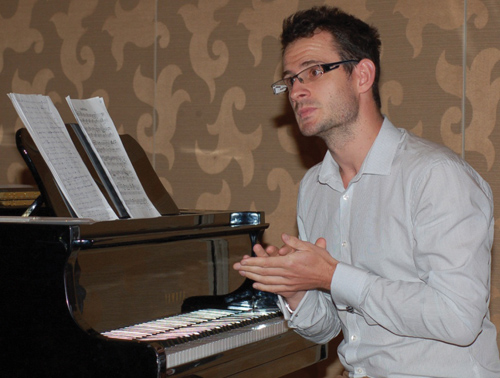
At a JSM 2012 session for the media, Significance author Tom Collins asks listeners if they can distinguish a Chopin mazurka from one created with a Markov chain model.
The magazine, a benefit of ASA membership, brings us fascinating stories that highlight the rich diversity of statistics. In addition, the magazine and website give us ways to reach the general public.
Significance magazine became a joint publication of the ASA and the Royal Statistical Society in 2010. The editorial board is made up of ASA and RSS members, and the editor, Julian Champkin, is a professional journalist.
I asked Champkin how Significance reaches the public. He explained, “Our biggest success has been an article on the profitability of robbing banks (June 2012). At least 50 newspapers, broadcasters, and websites around the world wrote pieces based on this article. Given the circulations and click-rates of the Washington Post, Los Angeles Times, and The Huffington Post (which were among them), I would estimate that the combined readership was over a million. It is this re-reporting of Significance articles that reaches the world.”
Champkin points out that the website—which offers more content than the magazine—is the perfect tool for outreach. Because of the website’s immediacy and accessibility, it attracts large numbers of readers from outside of our profession. For instance, a website obituary for Paul Meier achieved nearly 20,000 clicks within a week.
What did the public learn from this piece? Champkin replies, “As a journalist, I have only a vague grasp of the Kaplan-Meier estimator, but I now know that it increases understanding of death rates, that it helps to judge effectiveness of new treatments, and that, as a result, millions of lives have been saved. Someone reading the obituary would have gained that appreciation of the importance of statistics. Their mindset would have changed.”
Significance is also changing the mindset of students. ASA member Glorybeth Becker, who teaches AP Statistics in Maryland, uses the articles to enrich discussion of classroom topics. “The Formula That Killed Wall Street” (February 2012) piqued the curiosity of her students and reinforced the importance of checking assumptions. “Chopin, Mazurkas, and Markov” (December 2011) interested two students because of their musical backgrounds. Becker says “all AP Statistics teachers should become ASA members so they can get their hands on these wonderful resources.”
Now that you know how far a Significance article can reach, I hope you will write one yourself. Email article proposals and website pieces to significance@rss.org.uk. As Champkin says, “If you want people outside statistics to appreciate what you do, you have to tell them about it!”
Wrapping Up the Year
During 2012, I have enjoyed telling you how we are growing as an association and sharing the perspectives of many members who are contributing to our growth. I eagerly look forward to January, when Marie Davidian—the 2013 president of ASA—will tell us about her initiatives and the International Year of Statistics.
I wish you a successful New Year—a time for all of us to speak for statistics!

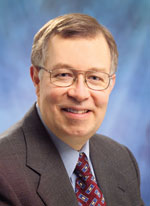
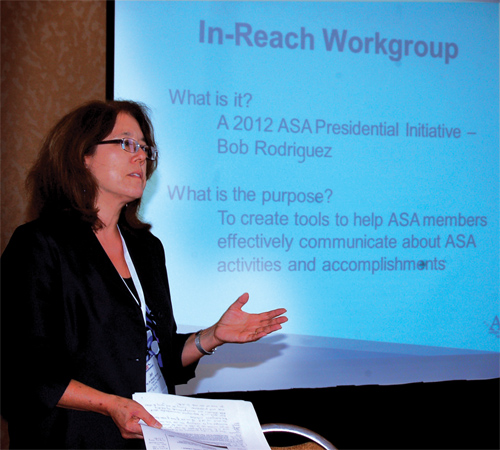
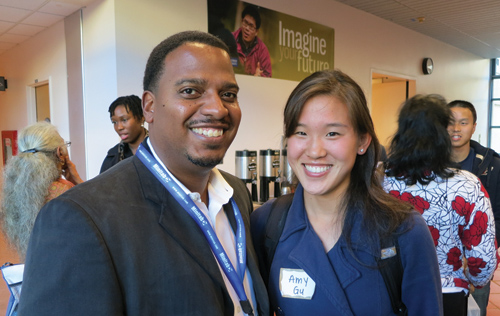
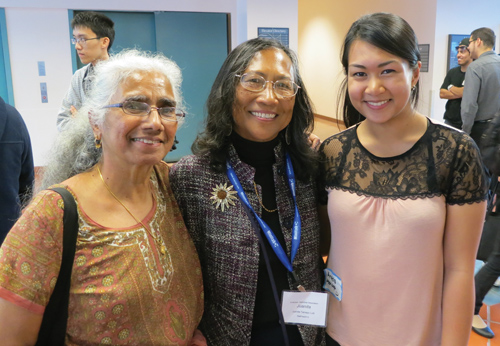









I’m not seeing a link to “My Volunteer Activities”.
Can you provide a clickable link?
It turns out that ordinary members (not a member of a committee, for example), do not see a “My Volunteer Activities” tab on the web page. This is far too funny, given this quote from the article: “The first audience we must reach is ourselves!”
Welcome!
Amstat News is the monthly membership magazine of the American Statistical Association, bringing you news and notices of the ASA, its chapters, its sections, and its members. Other departments in the magazine include announcements and news of upcoming meetings, continuing education courses, and statistics awards.
ASA HOME
Departments
Archives
ADVERTISERS
PROFESSIONAL OPPORTUNITIES
FDA
US Census Bureau
Software
STATA
QUOTABLE
“ My ASA friendships and partnerships are some of my most treasured, especially because the ASA has enabled me to work across many institutional boundaries and
with colleagues from many types of organizations.”
— Mark Daniel Ward
Editorial Staff
Managing Editor
Megan Murphy
Graphic Designers / Production Coordinators
Olivia Brown
Meg Ruyle
Communications Strategist
Val Nirala
Advertising Manager
Christina Bonner
Contributing Staff Members
Kim Gilliam